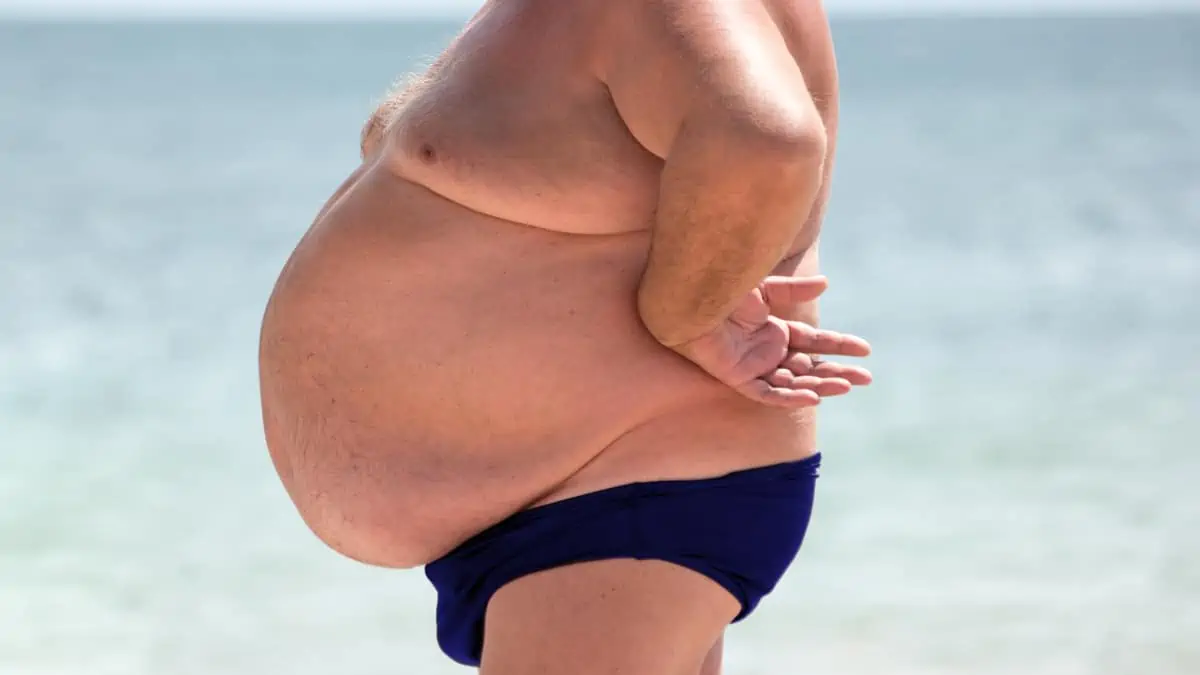90 inches is one of the largest waistline sizes in existence, so it’s no surprise that people who have a 90 inch waist are putting their health at great risk.
It’s also more complicated to lose weight when you have a 90″ waist because some types of exercise are impossible to perform due to your weight and the size of certain body parts.
Yet, where there’s a will, there’s a way. As you’re about to learn, there are viable strategies that someone with a 90 in waist can employ to significantly slim their stomach.
Related Guides:
What causes someone to have a 90 inch waist?

A combination of overeating and a lack of movement are usually the main culprits for someone having a 90 inch waist or a 95 inch waist. Having a lot of central fatness (also called abdominal obesity) independently increases your risk of all-cause mortality. [1] So it’s more important than ever to shift your excess weight so that you can regain control of your health.
The problem is that our modern lifestyles are so conducive to weight gain. Sure, there are a lot more gyms around nowadays, and there’s plenty of helpful advice on losing fat, but there’s also easy access to calorie-dense foods.
Of course, some people naturally store more body fat than others due to their genetics. But that granted, it still takes overeating and a sedentary lifestyle to put those genes into motion—people in more primitive cultures without access to high-calorie foods simply don’t become obese.
So, in other words, the environment that you live in can be a major reason for having excess stomach fat.
How to lose fat from your 90 inch waist

Although we frequently recommend that people seek slower and more sustainable weight loss, some people, especially those who are very obese, need to lose body mass as quickly as possible because their current health status is so poor.
Your doctor might recommend that you follow a very low-calorie diet, which typically means consuming between 800 and 1200 calories per day.
The trick when following diets like this is to eat highly satiating and voluminous foods. For example, eating 100 g of vegetables is way more filling and nutritious than consuming 100 g of chocolate.
So, while you need to drop your calorie intake in order to trigger weight loss, you don’t necessarily need to subsist on the scraps of the foods that you’d usually eat. Healthier foods have more “food volume” (they’re more voluminous) than junk foods, which means that your portion sizes don’t always have to drastically decrease on low-calorie diets. [2]
Exercise is also important for losing weight. However, since having a 90 inch waist can often cause joint pain—and since being obese can impede your movement—your best bet is to stick to waking and chair exercise until you lose an initial bulk of your body weight.
What benefits can you expect to experience?

Reducing the size of your 90″ waist will improve your mental and physical health. You’ll increase your mobility when you shift some of your excess weight, and you’ll feel happy knowing that your weight is now going in the direction of better health and a longer life.
It’s well known that slimming down from an obese BMI reduces your risk of chronic disease. But losing your excess fat can also improve your quality of life in the short term too. For example, you’ll be able to buy better-fitting clothes and walk around with less joint discomfort.
Another great benefit to switching to a low-calorie diet as an obese individual is that you can experience rapid weight loss. This can be highly motivating if you’ve always struggled with your weight and can encourage you to keep on track.
Conclusion: Slimming your 90 in waist successfully

When many people try to slim their 90 inch waist for the first time, they panic and feel like they have to do everything at once because they finally realize just how precarious a situation their body is in.
Yet, going all out on day one can make you feel overwhelmed and make you more likely to give up.
As such, your diet should be your number one priority. Yes, exercise is beneficial, but it can be impractical—or even impossible—when you’re very obese.
Let the calorie restriction do its job, and then increase your activity level once your mobility improves.
References
- Jayedi, A., Soltani, S., Zargar, M. S., Khan, T. A., & Shab-Bidar, S. (2020). Central fatness and risk of all cause mortality: systematic review and dose-response meta-analysis of 72 prospective cohort studies. BMJ, m3324. https://doi.org/10.1136/bmj.m3324
- Centers for Disease Control and Prevention. (2021, September 23). Cutting Calories. https://www.cdc.gov/healthyweight/healthy_eating/cutting_calories.html

